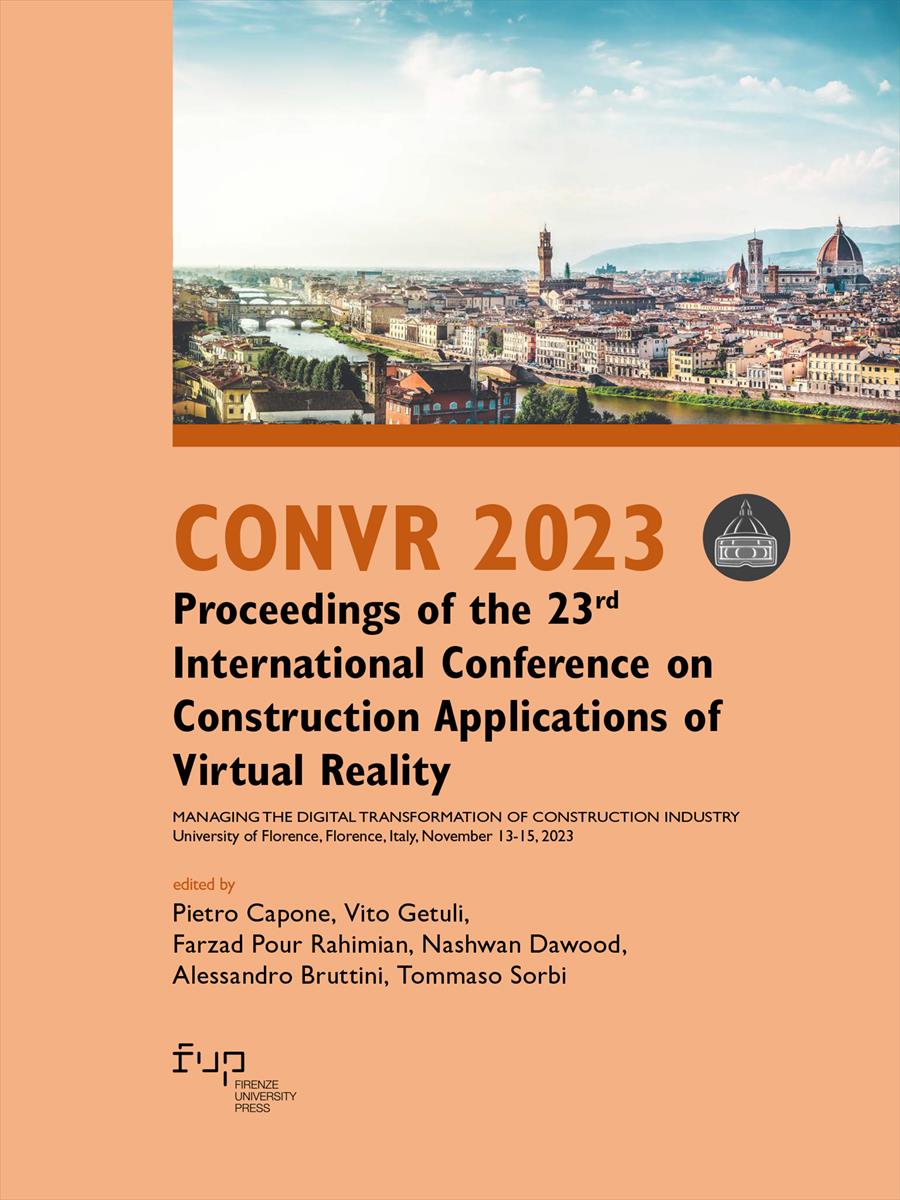- CONVR 2023 - Proceedings of the 23rd International Conference on Construction Applications of Virtual Reality
- A cura di Pietro Capone, Vito Getuli, Farzad Pour Rahimian, Nashwan Dawood, Alessandro Bruttini, Tommaso Sorbi
Generative Design Intuition from the Fine-Tuned Models of Named Architects’ Style
- Youngjin Yoo
- Hyun Jeong
- Youngchae Kim
- SeungHyun Cha
- Jin-Kook Lee
- © 2023 Author(s) |
- CC BY-NC 4.0
- DOI: 10.36253/979-12-215-0289-3.91
This paper suggests the potential application of generative artificial intelligence-based image generation technology in the field of architecture, for early phase shape planning, using the styles of renowned architects. The study employed the following approaches: 1) Intensive image generation based on the styles of 20 architects to test the AI's recognition ability and image quality. 2) Additional training was conducted for architects with low recognition rates to construct an enhanced learning model in the quality of image generation. 3) In addition to generating architectural visualization images using existing architects' design styles, alternative styles were proposed through design combinations, aiming to concretize ambiguous idea communication in the early stages of design and enhance its efficiency. The study sheds light on the future prospects of applying this generative AI model in the field of architecture
- Keywords:
- Design Style of Architects,
- Generative AI,
- Image Generation,
- Fine-tuning,
Yonsei University, Korea (the Republic of) - ORCID: 0009-0002-5362-328X
Yonsei University, Korea (the Republic of)
Yonsei University, Korea (the Republic of) - ORCID: 0000-0003-2009-0376
Korea Advanced Institute of Science Technology, Korea (the Republic of) - ORCID: 0009-0004-7001-2346
Yonsei University, Korea (the Republic of) - ORCID: 0000-0002-5179-6550
- Abdallah, Z., Du, L., & Webb, G. (2017). Data Preparation. In: Sammut, C., Webb, G.I. (eds) Encyclopedia of Machine Learning and Data Mining. Springer. DOI: 10.1007/978-1-4899-7687-1_62
- Akin, O. (1978). How do architects design. Artificial Intelligence and Pattern Recognition in Computer Aided Design, 65-104.
- Atilola, O., Tomko, M., & Linsey, J. S. (2016). The effects of representation on idea generation and design fixation: A study comparing sketches and function trees. Design studies, 42, 110-136. DOI: 10.1016/j.destud.2015.10.005
- Borji, A. (2023). Generated Faces in the Wild: Quantitative Comparison of Stable Diffusion, Midjourney and DALL-E 2. DOI: 10.48550/arXiv.2210.00586
- Chiu, M. L. (1995). Collaborative design in CAAD studios: shared ideas, resources, and representations. In Proceedings of International Conference on CAAD Future (Vol. 95, pp. 749-759).
- David, A., Joy, E., Kumar, S., & Bezaleel, S.J. (2022). Integrating Virtual Reality with 3D Modeling for Interactive Architectural Visualization and Photorealistic Simulation: A Direction for Future Smart Construction Design Using a Game Engine. Second International Conference on Image Processing and Capsule Networks, 300. DOI: 10.1007/978-3-030-84760-9_17
- Eastman, C.M. (1999). Building Product Models: Computer Environments, Supporting Design and Construction. (1st ed.). CRC Press: Florida, (Chapter 1).
- Fonseca, D., Redondo, E., Valls, F., & Villagrasa, S. (2017). Technological adaptation of the student to the educational density of the course. A case study: 3D architectural visualization, Computers in Human Behavior, 72, 599-611. DOI: 10.1016/j.chb.2016.05.048
- Goodfellow, I., Pouget-Abadie, J., Mirza, M., Xu, B., Warde-Farley, D., Ozair, S., ... & Bengio, Y. (2014). Generative adversarial nets. Advances in neural information processing systems, 27.
- Greenberg, D. P. (1974). Computer graphics in architecture. Scientific American, 230(5), 98-107. https://www.jstor.org/stable/24950079.
- Hu, E. J., Shen, Y., Wallis, P., Allen-Zhu, Z., Li, Y., Wang, S., ... & Chen, W. (2021). Lora: Low-rank adaptation of large language models. https://ar5iv.labs.arxiv.org/html/2106.09685.
- Karras, T., Laine, S., Aittala, M., Hellsten, J., Lehtinen, J., & Aila, T. (2020). Analyzing and improving the image quality of stylegan. In Proceedings of the IEEE/CVF conference on computer vision and pattern recognition (pp. 8110-8119). DOI: 10.1109/CVPR42600.2020.00813
- Kheir Al-Kodmany. (2001). Visualization Tools and Methods for Participatory Planning and Design. Journal of Urban Technology, 8(2), 1-37. DOI: 10.1080/106307301316904772
- Kim, J., & Lee, J. K. (2020). Stochastic detection of interior design styles using a deep-learning model for reference images. Applied Sciences, 10(20), 7299. DOI: 10.3390/app10207299
- Kim, J., Song, J., & Lee, J. K. (2019, January). Approach to auto-recognition of design elements for the intelligent management of interior pictures. In Proceedings of the 24th International Conference on Computer-Aided Architectural Design Research in Asia: Intelligent and Informed, CAADRIA (pp. 785-794). DOI: 10.52842/conf.caadria.2019.2.785
- Koutamanis, A. (2000) Digital architectural visualization. Automation in Construction, 9(4), 347-360. DOI: 10.1016/S0926-5805(99)00018-7
- Oppenlaender, J. (2022, November). The Creativity of Text-to-Image Generation. In Proceedings of the 25th International Academic Mindtrek Conference (pp. 192-202). DOI: 10.1145/3569219.3569352
- Oppenlaender, J., Visuri, A., Paananen, V., Linder, R., & Silvennoinen, J. (2023). Text-to-Image Generation: Perceptions and Realities. DOI: 10.48550/arXiv.2303.13530
- Ramesh, A., Dhariwal, P., Nichol, A., Chu, C., & Chen, M. (2022). Hierarchical text-conditional image generation with clip latents. DOI: 10.48550/arXiv.2204.06125
- Rombach, R., Blattmann, A., Lorenz, D., Esser, P., & Ommer, B. (2022). High-resolution image synthesis with latent diffusion models. In Proceedings of the IEEE/CVF Conference on Computer Vision and Pattern Recognition (pp. 10684-10695). DOI: 10.48550/arXiv.2112.10752
- Saharia, C., Chan, W., Saxena, S., Li, L., Whang, J., Denton, E. L., ... & Norouzi, M. (2022). Photorealistic text-to-image diffusion models with deep language understanding. Advances in Neural Information Processing Systems, 35, 36479-36494. DOI: 10.48550/arXiv.2205.11487
Informazioni sul capitolo
Titolo del capitolo
Generative Design Intuition from the Fine-Tuned Models of Named Architects’ Style
Autori
Youngjin Yoo, Hyun Jeong, Youngchae Kim, SeungHyun Cha, Jin-Kook Lee
DOI
10.36253/979-12-215-0289-3.91
Opera sottoposta a peer review
Anno di pubblicazione
2023
Copyright
© 2023 Author(s)
Licenza d'uso
Licenza dei metadati
Informazioni bibliografiche
Titolo del libro
CONVR 2023 - Proceedings of the 23rd International Conference on Construction Applications of Virtual Reality
Sottotitolo del libro
Managing the Digital Transformation of Construction Industry
Curatori
Pietro Capone, Vito Getuli, Farzad Pour Rahimian, Nashwan Dawood, Alessandro Bruttini, Tommaso Sorbi
Opera sottoposta a peer review
Anno di pubblicazione
2023
Copyright
© 2023 Author(s)
Licenza d'uso
Licenza dei metadati
Editore
Firenze University Press
DOI
10.36253/979-12-215-0289-3
eISBN (pdf)
979-12-215-0289-3
eISBN (xml)
979-12-215-0257-2
Collana
Proceedings e report
ISSN della collana
2704-601X
e-ISSN della collana
2704-5846
